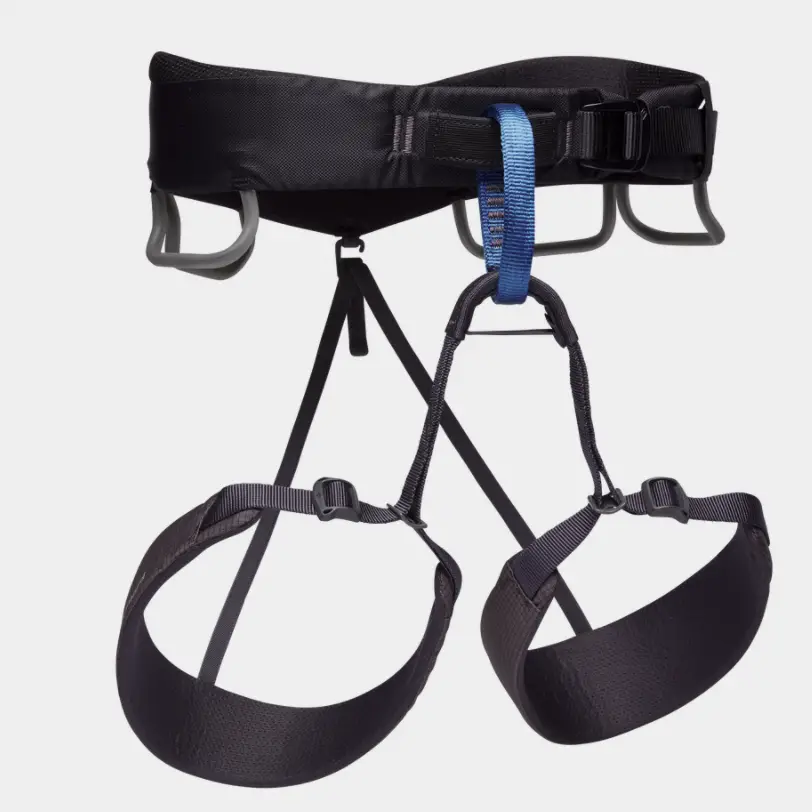
Having a great harness is critical to ensure your climbing experience is as smooth as possible. Therefore, we will share our recommendations, allowing you to find the best harness on the market for your beginners.
The best climbing harness for beginners is the Black Diamond Momentum due to its high durability, affordable price, and comfort.
The Black Diamond Momentum is a staple of the climbing community, and it’s earned its place. Affordable, durable, and comfortable, this harness has everything you need and nothing you don’t. However, if durability and longevity (a harness that can support you throughout your entire climbing journey) is not your top priority, and instead you prefer the option of having a “drop seat” or have padding as a top priority, read on to see some other options that might be better suited for you!
Best Harness For Beginners: The Black Diamond Momentum

Verdict: This is a harness that can fit the needs of every level in your climbing journey.
The Good: This product will last your entire climbing journey due to the sturdy materials Ny.210D, and Poly 400D which both have ripstop technology.
The Bad: Mid-premium brand means the price may not be suitable for a budget-sensitive climber. That being said, most people see their first tears within over half a decade with weekly usage. This is impressive as most harnesses of this price-range usually have a lifespan of 1-3 years. Hence, you will be getting extreme value for the price of the purchase.
Black Diamond equipment has been a leader in this industry since 1957 so it comes as no surprise that they can deliver such a superior product. As a beginner you want to try all types of climbing to figure out which style is the best for you and Black Diamond’s Momentum allows you the opportunity to do so by being a flexible harness accommodating all-around climbers.
Furthermore, you do not want to start each climb frustrated by the fact that your harness needs constant re-adjustment. Luckily, the Momentum’s pre-threaded Speed Adjust waist buckle will save you time and eliminate errors for when tying in. Moreover, the Dual Core Construction™ and TrakFIT leg-loop padding will keep you comfortable even if you are hanging for a while in blazing summers or chillier fall weather.
Basically, the Momentum is extremely comfortable, extremely easy to use, and will work for just about any sport. At a price point of less than $80, it’s impossible to beat for the first-time climber.
Best Harness for Women: Petzl Luna
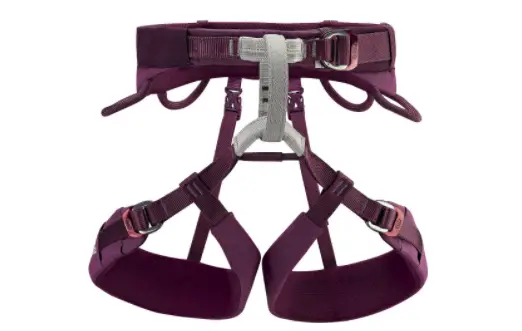
Verdict: This harness is not only affordable, but also great for women due the impressive EndoFrame technology that optimizes distribution of pressure.
The Good: The flexible rear gear loops will not interfere with what you pack, while the angled front loops make accessing gear extremely easy.
The Bad: This harness has been known to run smaller to size, therefore it may be a risk to order online before trying.
Similar to Black Diamond’s Momentum, the Luna by Petzl is also built for climbing in any season. However, thanks to Luna’s EndoFrame technology this harness is more suitable for women’s body types due to the contoured waist belt that conforms to the lower back of its user which helps distribute pressure while hanging.
Additionally, the longer rise for more precise placement of the waist belt, and adaptable waist belt-to-leg-loop ratio is designed for a women’s specific fit. This means, if your waist or legs are a unique proportion, this harness will adjust to fit you comfortably. Not to mention it’s DoubleBack buckles eliminates the need for you to double-back yourself, which will save you time and take away one more thing to worry about.
Most Comfortable Harness: Petzl Sama

Verdict: This harness is great for hanging belays and multi-pitch routes that require you to wear it for hours on end.
The Good: Easy to get on and off, the elasticized leg loops will allow you to adjust with ease while the flexible waist belt will enhance your range of motion.
The Bad: This is a premium harness and therefore will have a higher price tag, hence if you are looking to just try out the sport it may not be the best harness for you.
Similar to the Luna by Petzl, this harness also uses EndoFrame technology to effectively distribute weight and pressure. That being said, what differentiates this harness from others is the webbed waist padding and thick waist belt which makes it a superior option in terms of support. Unlike other harnesses, the likelihood of chafing from hanging, belaying, or climbing is low.
Furthermore the fitted elastic leg loops will allow you to easily walk and climb, thereby giving you access to your full range of motion. Finally, the single waist adjustment allows it to cinch up quickly and release smoothly, ensuring you can get in and out in record time.
However, with a higher price, this isn’t a harness you buy just to try out climbing. If you know you love the sport, it might be worth spending a few extra bucks; if you’re still hesitant, I’ll refer you back to the Momentum.
Best for Multi-Sport Users: Arc’teryx C-quence
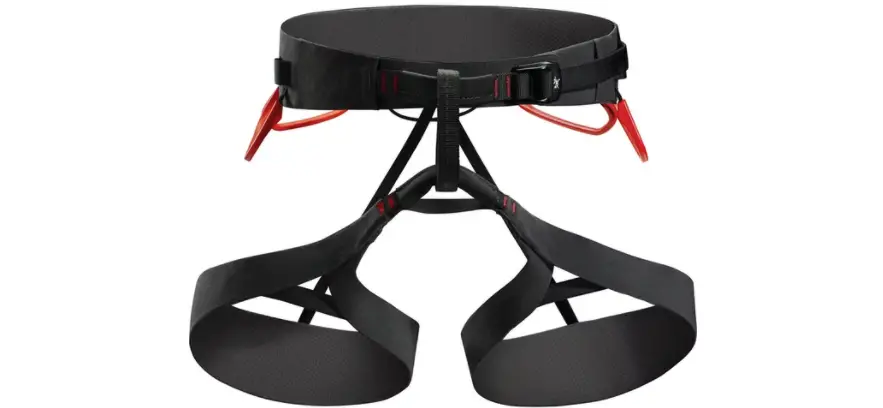
Verdict: The C-quence will allow you to do more than just sport climbs in gyms, as ice climbers and beginner alpinists will also be able to climb using this harness.
The Good: Very lightweight, easy to adjust and reliable.
The Bad: May not have the best fit for curvier bodies.
There are so many adjustable features from the leg loops to the webbing through the automatic double-back buckle. In addition, the gear loops are sturdy and are designed to sit slightly flared out from your body when worn which makes racking up a breeze as you will not be missing any gear loops with your carabiner due to its vertical positioning. The minimal, thin and perforated lining ensures you can be comfortable even if temperatures creep near 26 degrees celsius.
Meanwhile, you can expect limited chafing even with the lightest clothing soaked in sweat. It also has a generous opening, which makes for snag-free, no-look unracking and re-racking. Finally, instead of relying on foam to distribute your weight, the Warp Strength Technology and superfine wires inside the four-way stretch fabric will support and disperse pressure without adding any noticeable bulkiness.
Best of the Rest
These are harnesses that rank highly and are very popular in the climbing community, in the case that the previous options did not satisfy your needs or wants:
- Petzl Adjama: Great for any climbers on long routes and those who prefer having an entire rack full with shoes, jackets and anchor building tools thanks to its accessible rear gear loops. It is relatively affordable and can risk being a tad bulky due to its capacity to hold everything you may need for the climb.
- Mammut Ophir 3: Has a great lower-tie in point to prevent abrasions and create a higher safety margin. Additionally, the tie-in point and belay loops will reveal red threads to indicate it needs to be replaced, therefore allowing you to always be safe and avoid using worn out tools on your climbs.
- Edelrid Moe: This one is great for any climbers who value sustainability as it is FSC certified. Moreover, it has an abrasion protector to maximize its lifespan, a huge sizing spectrum with a guaranteed centered tie-in point, and an easy glider buckle to provide a secure fit using the least amount of time.
- Black Diamond Solution Guide: This harness is great for any traditional or multi-pitch climber, and has oversized front gear loops for loading up any gear you may need to bring on your climb. The material is also extremely durable, but does not provide enough comfort to be a solution for long belay sessions.
What to Look For in A Climbing Harness
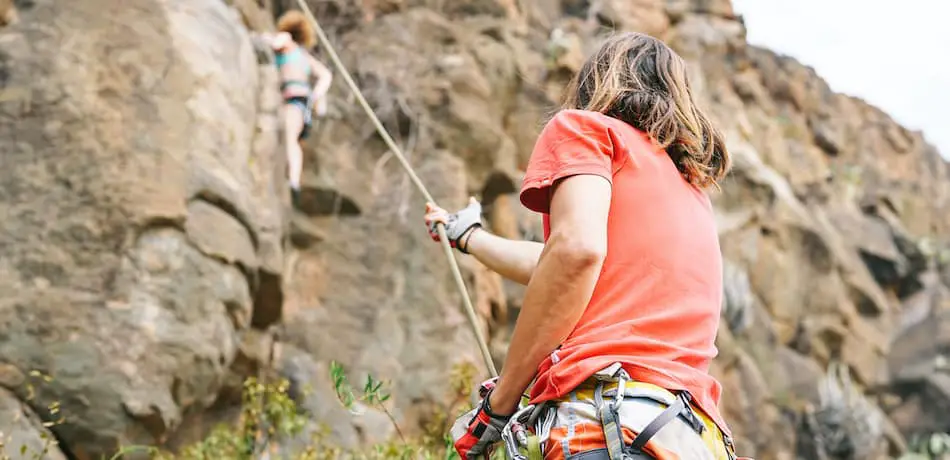
When identifying the best harness you must conduct a CFV test which considers your Comfort, the Features and Versatility of the harness.
Determining if your Harness is Comfortable
The best way to determine if your harness is comfortable is to actually hang from it. Many stores will have ropes attached to the ceiling for just this.
However, in lieu of that option, there are three things you can do to obtain a benchmark, allowing you to understand if you need to try another harness:
- If the waist belt is moving excessively or shifting, tighten it until the shifting stops. You should not be able to pull the waist belt down over the hips. If you still experience shifting on the tightest level, you must look for a smaller harness.
- If there are any noticeable points of pressure e.g. digs into your hip, then you must consider trying a different harness. See if you can put a finger underneath the strap. If you can easily fit one under, the harness is too loose. If you cannot get even the tip of your finger under, the harness is too tight.
- If you are using your core muscles to stand upright, adjust the rise of the harness. Each leg loop has a strap on the back that can be adjusted in length and shortening the rise should allow you to remain upright without much effort. If adjusting the rise does not help, try a different harness.
Features to Consider When Purchasing a Harness
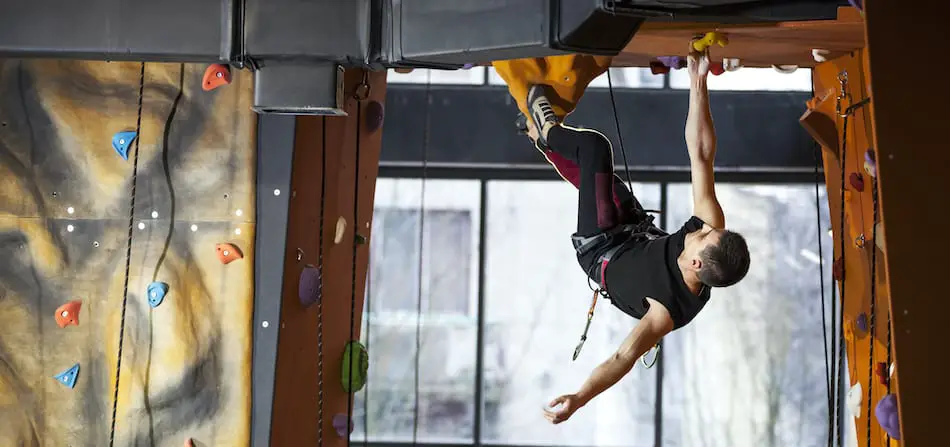
For beginners it is important to understand the functionality of the gear loops, the range of adjustability the harness allows, and the weight.
The number of gear loops you will need depends on the type of climb you want to partake in. For sport or indoor climbing two gear loops is enough. However, for traditional, ice or alpine climbing a minimum of four belt loops is ideal due to the fact that you may need to hold ice screws or other types of tools.
As for adjustability, unless you are climbing in a gym or for sport you would want a harness that provides buckles on the leg loops despite the extra weight they may bring. This is because depending on the outdoor conditions you may need thicker or thinner clothing and want to make sure that your harness can fit over the clothing. Auto adjustments will save you time over the manual double back adjusters, but if your legs are wider in proportion to the rest of your body having more control by opting for a harness with manual adjusters may be ideal.
Finally there may often be a choice between prioritizing weight or prioritizing padding. This decision is dependent on how long each climb will take, but also comes down to personal preferences. Traditionally, people who climb in gyms or mountaineers prefer lighter harnesses whereas traditional and ice climbers prefer thicker and more durable padding. However, if you have any waist issues or a fragile back it would be best to opt for more padding despite the type of climb.
Versatility of Your Harness
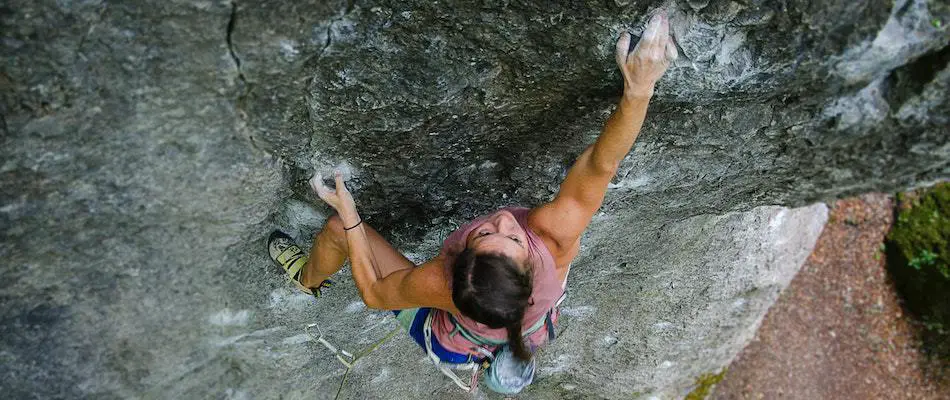
When determining how versatile your harness should be, a key consideration outside of the type of climbs you participate in is the seasons you plan to climb in. Specifically, if you plan to climb during colder climes it is worthwhile to look for a looser harness, especially if you plan on wearing snow pants and coats. As for the type of climbs, each have specific features:
- Sport: Single automatic or double-back waist belt buckles, thin belay loops to save on weight and minimal leg adjustability.
- Traditional: Thick padding, especially the lumbar padding to increase comfort and stabilize the lower back area, with a haul loop for carrying up a secondary rope.
- Ice or Mixed: Very similar to a traditional harness but made to cope with winter conditions, specifically the gear loops are designed with clipper slots to hold screws and other tools.
- Alpine or Mountaineering: These tend to offer all season versatility and be lightweight due to the thin material and belay loop.
If all four of these types of climbs are of interest to you, it is possible to find a flexible harness that will fit your needs when participating in each activity. However if you are interested in harnesses designed for canyoneering, competitions, big wall or full body/rescues, you may need to purchase an additional specialized harness.
How to Fit Into Your Climbing Harness
Before choosing any harness it is important to talk to a store expert, make sure it fits snug around your waist and legs, and if possible hang from it first if the store has facilities allowing you to do so. After you have chosen a comfortable harness to try on, put it on in the following fashion:
- Loosen straps on both leg loops if possible and the waist belt strap.
- Step into the harness, and make sure the:
- leg loops are not crossed
- belay loop is not twisted and instead facing the front of the harness
- waist belt is not upside down
- Place the waist belt above your iliac crest which is usually near the belly-button level for most people. Having your waist belt above your hips, will allow you to avoid accidentally slipping out of the harness in the case that you fall upside down.
- Secure the waist belt tightly after it is situated in the correct area.
- Adjust the leg loops one at a time. Some will not have adjustable leg loops and instead have an elastic to allow for stretch. Make sure the leg loops are at a 2 finger gap between the loop and your groin area.
- Tighten your leg loops to a comfortable level and if needed, double back the buckles on each loop.
